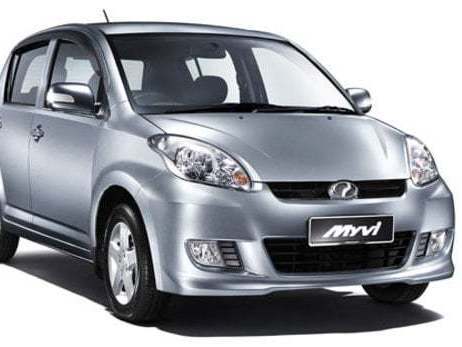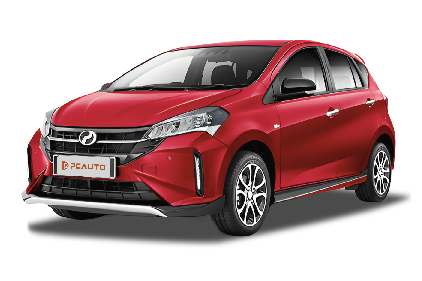Q
What is the boot space capacity of the Perodua Myvi?
If you're in the Malaysian market for a practical, budget-friendly B-Segment SUV, the Perodua Ativa is definitely one to check out – especially if you're a young family or first-time buyer looking to maximize value without breaking the bank. Under the hood, you've got a peppy 1.0L turbocharged engine paired with a D-CVT gearbox, and let me tell you, the fuel economy is a real standout here – 4.7L/100km according to the official figures. That makes it perfect for zipping around the city. What really sets it apart in its class, though, is the standard ASA 3.0 advanced safety suite, which includes pre-collision warning and lane keep assist – solid safety kit you don't always see as standard in this segment.
Size-wise, it's compact on the outside, but Perodua has done a nice job optimizing the interior space. The rear seats fold 60:40, so you get decent flexibility when you need to haul more stuff. Now, if we're talking competitors, the Ativa's trump cards are Perodua's well-established after-sales network and generally lower maintenance costs. But let's be real – if you're craving more power or a plusher interior, you might need to stretch that budget a bit.
My advice? Head down to a dealership, take it for a spin, and see if it fits your daily needs. Oh, and keep an eye out for promotions – Perodua often runs deals like free service packages or low-interest financing, which can sweeten the deal even more.
Special Disclaimer: This content is published by users and does not represent the views or position of PCauto.
Related Q&A
Q
What mileage for MYVI spark plugs?
According to Perodua's official recommendation, the mileage for replacing the spark plugs of the Myvi is usually between 40,000 and 60,000 kilometers. The specific interval depends on the type of spark plugs used in the vehicle and the driving conditions. The original equipment generally comes with ordinary nickel - alloy spark plugs. If you upgrade to iridium or platinum spark plugs, the replacement interval can be extended to 80,000 - 100,000 kilometers.
It's worth noting that if you often experience difficulties with cold starts, unstable idling, or an abnormal increase in fuel consumption, it may be a sign of spark plug aging, and you need to have them checked in advance. The hot and humid climate in Malaysia can accelerate the wear of spark plug electrodes. It is recommended to check the condition of the spark plugs during regular maintenance. At the same time, use original or equivalent - quality accessories that meet the specifications of the Myvi engine (such as the heat range). Inferior spark plugs may lead to a decrease in ignition efficiency and even damage the ignition coil.
For the turbo - charged Myvi X version, since the engine operates at a higher temperature, it is recommended to shorten the replacement cycle by about 20% to ensure optimal performance.
Q
What is the NCAP rating of Perodua Myvi?
The Perodua Myvi has achieved a 5-star rating in the ASEAN NCAP (ASEAN New Car Assessment Programme) tests. This result showcases its excellent performance in terms of safety features. The specific test items include adult occupant protection, child occupant protection, and safety assist systems. The Myvi is equipped with multiple safety features such as dual airbags, an ABS anti - lock braking system, an EBD electronic brake - force distribution system, and a Vehicle Stability Control (VSC) system. All these features have helped it score high in the crash tests.
For Malaysian consumers, choosing a vehicle with a high NCAP rating is very important as it is directly related to the safety guarantee during daily driving. The rating criteria of ASEAN NCAP are similar to those of other NCAP organizations globally, but it pays more attention to the actual road conditions and driving habits in Southeast Asia, thus having greater regional reference value.
Apart from the Myvi, there are also other models from different brands in the Malaysian market that have achieved a 5 - star rating. When purchasing a vehicle, consumers can compare the safety features and test results of different models to ensure they select the vehicle that best suits their needs.
Q
How many spark plugs are in Myvi?
The Perodua Myvi has achieved a 5-star rating in the ASEAN NCAP (ASEAN New Car Assessment Programme) test, which showcases its excellent performance in terms of safety features. The specific test items include adult occupant protection, child occupant protection, and safety assist systems. The Myvi is equipped with multiple safety features such as dual airbags, an ABS anti-lock braking system, an EBD electronic brake-force distribution system, and a Vehicle Stability Control (VSC) system, all of which have earned it high scores in the crash tests.
For Malaysian consumers, choosing a car model with a high NCAP rating is crucial as it directly relates to the safety assurance in daily driving. The rating criteria of ASEAN NCAP are similar to those of other NCAP organizations globally, but it pays more attention to the actual road conditions and driving habits in Southeast Asia, making it more regionally relevant. Besides the Myvi, there are other car models from different brands in the Malaysian market that have also received a 5-star rating. When purchasing a car, consumers can compare the safety features and test results of different models to ensure they select the vehicle that best suits their needs.
Q
Is myvi a reliable car?
The Myvi is a reliable car. Judging from its sales performance, the Myvi has been the best - selling car model in Malaysia from 2005 to 2014. As of now, its cumulative sales have reached 1,491,765 units. In 2024, it remains the best - selling hatchback in Malaysia and is very popular among consumers. In terms of product characteristics, it offers high cost - effectiveness. The price ranges from RM 46,500 to RM 59,900, and it comes with a rich set of features. It has low fuel consumption, being equipped with a 1.3L or 1.5L Dual VVT - i engine, and the official minimum fuel consumption is 4.5L per 100km. In terms of space, as a B - class hatchback, it has reasonable body dimensions. The rear seats can be folded down, making it highly practical. In terms of safety, the current model is equipped with advanced safety features such as Perodua Smart Drive Assist (PSDA). So, whether it's the market's recognition or its own characteristics, they all indicate that the Myvi is a reliable car.
Q
How much is myvi fuel consumption?
As one of the most popular national cars in Malaysia, the fuel economy of the Perodua Myvi varies depending on the model and driving conditions. According to official data, the fuel consumption of the latest Myvi in mixed conditions is about 5.3 to 5.6 liters per 100 kilometers (for the 1.5L engine version), which means it can travel about 18 to 19 kilometers per liter of gasoline. The 1.3L engine version may be even more fuel - efficient. The actual performance is affected by driving habits, road conditions, and the vehicle's maintenance status. For example, frequent rapid acceleration or driving in congested urban areas can significantly increase fuel consumption.
It is recommended that car owners regularly check the tire pressure, replace the air filter, and use the recommended engine oil to optimize fuel economy. Additionally, the Myvi has a fuel tank capacity of 36 liters, and theoretically, it can have a cruising range of about 600 kilometers when the tank is full.
For car owners who want to save more fuel, they can try some economical driving techniques such as smooth acceleration and anticipating road conditions to reduce sudden braking. These methods are applicable to all fuel - powered vehicles, which can not only reduce the cost of using the car but also reduce mechanical wear.
Q
How many Litres is a MYVI fuel tank?
The fuel tank capacity of the Perodua Myvi varies slightly depending on the model. The first - generation Myvi (2005 - 2011) had a fuel tank capacity of 40 liters. For the second - generation (2011 - 2017) and third - generation (2017 to present) Myvi, the fuel tank capacity increased to 36 liters for the 1.3L models and 40 liters for the 1.5L models. This design is to balance the fuel - economy requirements of different engine displacements. Malaysian car owners should note that the fuel tank capacity directly affects the driving range. Usually, a 1.5L model can travel about 500 - 600 kilometers on a full tank under combined driving conditions, which specifically depends on driving habits and road conditions. It is recommended that car owners regularly check the fuel system and maintain good driving habits to optimize fuel consumption. Meanwhile, it should be noted that the Myvi only needs to use RON95 gasoline and there's no need to use higher - grade fuel. This can not only meet the daily commuting needs but also save fuel costs.
Q
How many cylinders are in the MYVI?
As one of the most popular national cars in Malaysia, the engine configurations of the Perodua Myvi vary according to different years and versions. Currently, the mainstream models are equipped with two types of Dual VVT - i four - cylinder naturally aspirated engines, namely the 1.3L (1NR - VE) and 1.5L (2NR - VE). Therefore, all Myvi models feature a four - cylinder design. This four - cylinder layout ensures smooth power delivery while taking fuel economy into account, making it highly suitable for the urban road conditions in Malaysia.
It's worth mentioning that four - cylinder engines, due to their simple structure and low maintenance costs, are widely used in B - segment models in the local market. For example, the Proton Saga and Honda City also adopt a similar layout. The 1.5L version of the Myvi can output 102 horsepower and 136 Nm of torque. Coupled with its lightweight body design, it can offer a well - balanced performance whether driving on the congested streets of Kuala Lumpur or cruising on the highway.
For readers who want to learn about engine technology, they can note that the Dual VVT - i system used in the Myvi can intelligently adjust the valve timing. This technology shared by Toyota helps to improve fuel efficiency by about 15%. That's why the Myvi has remained one of the most fuel - efficient cars in Malaysia for years.
Q
Are Myvi and vios the same engine?
Some models of the Myvi and the Vios use the same engine. Daihatsu and Perodua have a joint - venture engine production plant in Negeri Sembilan, Malaysia, which provides power for multiple models including the Vios. Some models of the Vios and the Myvi are equipped with the 1.5L Dual VVT - i engine. This engine features high efficiency, reliability, and economy. Although its power is not extremely strong (the official 0 - 100km/h acceleration time of the Myvi 1.5 is 10.2 seconds), its low fuel consumption and durability are well - loved by consumers. However, these two cars have different positioning and market targets. Even if they share the engine platform, there are differences in vehicle tuning, configuration, and the overall driving experience.
Q
What kind of gearbox is Myvi?
The Myvi is equipped with a Dual Mode CVT (D-CVT) transmission, which is a dual-mode continuously variable transmission. Compared with traditional CVT transmissions, it has an additional gear for high-speed driving, which helps the vehicle achieve better fuel efficiency.
In daily driving, this transmission drives the vehicle in CVT mode. Thanks to the operation of the steel belt, the vehicle moves smoothly and linearly, enhancing comfort. What makes the D-CVT special is that it automatically switches to the gear mode when driving at high speeds. Different from CVT transmissions of other brands, when driving at high speeds, the engine speed of vehicles with ordinary CVT transmissions will increase, the engine noise will get louder, and the fuel consumption will rise. Moreover, the power will decline after exceeding the maximum horsepower speed. However, after the gear of the D-CVT engages, the engine speed decreases, allowing the engine to maintain a reasonable speed and providing the vehicle with continuous and abundant power.
Q
Does Myvi use CVT?
Yes, the Perodua Myvi does use CVT (Continuously Variable Transmission) technology in some models, especially the newer ones. For instance, the third-generation Myvi, launched in 2017, and its subsequent versions are equipped with D-CVT (Dual Mode Continuously Variable Transmission) to offer a smoother driving experience and better fuel efficiency. CVT technology optimizes engine performance through continuously variable gear ratios. Compared with traditional automatic transmissions, it can adapt to driving conditions more flexibly, thereby enhancing overall driving comfort. However, earlier Myvi models may have used a traditional 4-speed automatic transmission. So, whether a specific model is equipped with a CVT needs to be confirmed based on the model year and configuration. For Malaysian consumers, the advantages of CVT lie in its smoothness and fuel - saving performance during city driving, which is very suitable for the common local traffic conditions. But if you're looking for more direct power feedback, some drivers may prefer the manual transmission version. If you're considering buying a Myvi, it's recommended to check the official specifications or consult a dealer to confirm the transmission type. You can also take a test drive to see if the actual performance of the CVT meets your driving preferences.
Popular Cars
Model Year
Car Compare
Car Photo
Latest Q&A
Q
How much did a new 2018 beetle cost?
The 2018 Volkswagen Beetle had a starting price range of approximately RM120,000 to RM180,000, depending on the trim and options. The entry-level 1.2 TSI Design model was the most affordable, while the top-spec 2.0 TSI R-Line version approached RM180,000—though final pricing could vary with optional extras and dealer promotions.
As a timeless classic, the 2018 Beetle kept its retro charm but packed modern tech like a touchscreen infotainment system and active safety features. Under the hood, buyers could choose between the fuel-efficient 1.2T or the more spirited 2.0T engine.
Fair warning: Volkswagen discontinued the Beetle in 2019, so you’ll only find it on the used market now. That said, its iconic design and nostalgic appeal still make it a hit among collectors. If you’re eyeing a pre-owned model, always check the vehicle history and maintenance records to snag a solid deal.
Q
What engine does a 2018 VW Beetle have?
The 2018 Volkswagen Beetle offered two gasoline engine options across different markets. The primary powerplant was a 1.2-liter TSI turbocharged inline-four, delivering 105 horsepower and 175 Nm of torque, paired with a 7-speed DSG dual-clutch transmission. This compact forced-induction engine struck a balance between urban fuel efficiency and strong low-end torque.
Higher-spec variants featured an optional 1.4-liter TSI turbocharged unit, bumping output to 150 horsepower. Both engines adopted direct fuel injection and belonged to VW’s widely used EA211 modular family, featuring modern tech like lightweight aluminum blocks.
Though retaining its iconic silhouette, this generation Beetle actually shared its underpinnings with the Golf, inheriting the brand’s proven front-wheel-drive architecture. This platform commonality also translated to easier maintenance, as local dealerships were well-versed in servicing these powertrains thanks to extensive parts sharing across VW’s lineup.
Q
What are the different models of the 2018 VW Beetle?
The 2018 Volkswagen Beetle comes in three main trims: Classic, Trendline, and Sport. All models are powered by a 1.2-liter TSI turbocharged engine delivering 105 horsepower, paired with a 7-speed DSG dual-clutch transmission—perfect for city driving with its nimble handling and solid fuel efficiency.
The entry-level Classic trim rolls on 16-inch wheels and features a basic multimedia system. Stepping up to the Trendline adds 17-inch wheels, fog lights, and chrome accents. The Sport trim leans into its name with 18-inch wheels, a sport-tuned suspension, and unique interior color options.
This generation keeps the Beetle’s iconic retro curves but modernizes them with touches like LED daytime running lights. Inside, you’ll find color-matched dash panels, and with 310 liters of trunk space, it’s more practical than most small cars in its class.
Since the Beetline was discontinued in 2019, the 2018 model stands as the last new generation, making it a rising collector’s item—especially the convertible, which holds strong appeal in the used market. For maintenance, stick to routine service every 15,000 km or 12 months, and regular 95-octane fuel is all it needs.
Q
Does the 2018 Beetle have Apple CarPlay?
The 2018 Volkswagen Beetle did come equipped with Apple CarPlay, integrated into its Composition Media infotainment system. This allowed iPhone users to seamlessly connect for navigation, music, and other apps. The system also supported Android Auto, catering to different smartphone users with its intuitive and responsive interface—definitely a plus for convenience on the road.
That said, some early-production 2018 models might require a software update to activate the feature, so it’s worth checking with an official dealer to confirm your car’s specs or available upgrades. Also, wireless Apple CarPlay wasn’t standard across all trims; it depended on the factory-installed options.
For fans of classic styling who still want modern tech, the Beetle struck a nice balance between retro charm and everyday usability. Competitors like the Mini Cooper offered similar connectivity, but let’s be honest—the Beetle’s iconic design was always its standout feature.
Q
What is the fuel economy of the 2018 Beetle?
The 2018 Volkswagen Beetle's fuel efficiency varies by powertrain. The 1.2L TSI turbocharged version delivers a combined fuel consumption of around 5.5L/100km, while the 1.4L TSI model is slightly thirstier at approximately 6.0L/100km – both perform best with 95-octane petrol.
You'll likely see higher consumption in city driving, but it cruises efficiently on highways thanks to its classic aerodynamic design. For better mileage, stick to routine maintenance like cleaning the air filter and keeping tyres properly inflated. These small habits can help squeeze out extra kilometres per litre.
Though discontinued, the 2018 Beetle remains popular in the used car market – its iconic styling and decent fuel economy make it a practical daily driver. Just remember real-world figures depend heavily on driving style and road conditions, so check owner forums for real-life feedback.
View MoreRelated News

Donald Trump praised Malaysia's adorable little car, Perodua Myvi received acclaim
LienDec 9, 2025

Since Its Launch in 2005, the Perodua Myvi has Cumulatively Sold Over 1,559,000 Units in 20 Years
WilliamMay 13, 2025

Perodua Myvi : A Value Choice for Worry-Free Car Purchases
LienMar 25, 2025

Own Perodua Myvi for less than RM 60,000: The best choice for city commuting?
LienOct 16, 2024

Perodua Traz (B66D) officially launched, priced from RM76,100 to RM81,100
WilliamDec 17, 2025
View More


















Pros
Cons